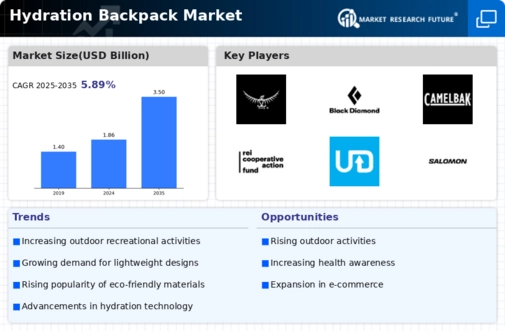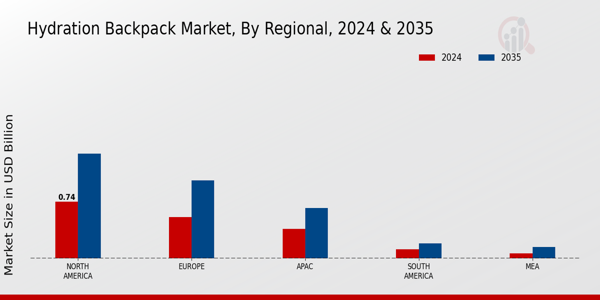Market Growth Projections
The Global Hydration Backpack Market Industry is poised for substantial growth, with projections indicating a market size of 1.86 USD Billion in 2024 and an anticipated increase to 3.5 USD Billion by 2035. This growth reflects a compound annual growth rate (CAGR) of 5.92% from 2025 to 2035, driven by various factors including rising outdoor activity participation, technological advancements, and increased health awareness. As the market evolves, it is likely to witness innovations that cater to the changing preferences of consumers, further enhancing its appeal and market share.
Increased Health Awareness
Heightened health awareness among consumers is a crucial driver of the Global Hydration Backpack Market Industry. As individuals become more conscious of their health and fitness, the demand for products that facilitate hydration during physical activities rises. Hydration backpacks are increasingly viewed as essential gear for maintaining optimal hydration levels while engaging in outdoor sports. This shift in consumer behavior is likely to contribute to the market's growth trajectory, with projections indicating a rise to 1.86 USD Billion in 2024. Brands are responding by developing products that emphasize hydration efficiency, further aligning with consumer health goals.
Expansion of E-commerce Platforms
The expansion of e-commerce platforms plays a vital role in the Global Hydration Backpack Market Industry. As online shopping becomes more prevalent, consumers have greater access to a variety of hydration backpacks from different brands. This accessibility allows for informed purchasing decisions based on reviews and product comparisons. E-commerce platforms also enable brands to reach a global audience, facilitating market penetration in regions where traditional retail may be limited. This trend is expected to contribute to the market's growth, with projections indicating a potential increase to 3.5 USD Billion by 2035.
Environmental Sustainability Trends
The growing emphasis on environmental sustainability is reshaping the Global Hydration Backpack Market Industry. Consumers are increasingly seeking eco-friendly products made from recycled materials and sustainable manufacturing processes. Brands that prioritize sustainability not only appeal to environmentally conscious consumers but also differentiate themselves in a competitive market. For example, several companies are now producing hydration backpacks using biodegradable materials, which resonate with the values of modern consumers. This trend is expected to drive market growth as awareness of environmental issues continues to rise, potentially leading to a CAGR of 5.92% from 2025 to 2035.
Rising Outdoor Activities Participation
The increasing participation in outdoor activities such as hiking, cycling, and running drives demand in the Global Hydration Backpack Market Industry. As more individuals engage in these activities, the need for convenient hydration solutions becomes apparent. The market is projected to reach 1.86 USD Billion in 2024, reflecting a growing awareness of the importance of hydration during physical exertion. This trend is particularly pronounced among millennials and Gen Z, who prioritize health and fitness. Consequently, brands are innovating to create lightweight, ergonomic designs that cater to this demographic, further propelling market growth.
Technological Advancements in Hydration Systems
Technological innovations in hydration systems significantly influence the Global Hydration Backpack Market Industry. Manufacturers are increasingly integrating features such as insulated reservoirs, advanced filtration systems, and smart hydration monitoring technologies. These advancements enhance user experience and promote healthier hydration habits. For instance, some backpacks now include built-in sensors that track fluid intake, appealing to health-conscious consumers. As these technologies become more prevalent, they are likely to attract a broader audience, contributing to the anticipated market growth to 3.5 USD Billion by 2035. This evolution indicates a shift towards more sophisticated hydration solutions.























